 The coronavirus pandemic and the climate emergency have highlighted the weaknesses of free-market capitalism.
The coronavirus pandemic and the climate emergency have highlighted the weaknesses of free-market capitalism.
Governments around the world have intervened massively to provide economic support to people and businesses affected by the pandemic through grants and furlough schemes. They have also stressed the importance of collective responsibility in abiding by lockdowns, social distancing and receiving vaccinations.
The pandemic has also highlighted the huge inequalities around the world. The rich countries have been able to offer much more support to their people than poor countries and they have had much greater access to vaccines. Inequality has also been growing within many countries as rich people have gained from rising asset prices, while many people find themselves stuck in low-paid jobs, suffering from poor educational opportunities and low economic and social mobility.
The increased use of working from home and online shopping has accelerated the rise of big tech companies, such as Amazon and Google. Their command of the market makes it difficult for small companies to compete – and competition is vital if capitalism is to benefit societies. There have been growing calls for increased regulation of powerful companies and measures to stimulate competition. The problem has been recognised by governments, central banks and international agencies, such as the IMF and the OECD.
 At the same time as the world has been grappling with the pandemic, global warming has contributed to extreme heat and wildfires in various parts of the world, such as western North America, the eastern Mediterranean and Siberia, and major flooding in areas such as western Europe and China. Governments again have intervened by providing support to people whose property and livelihoods have been affected. Also there is a growing urgency to tackle global warming, with some movement, albeit often limited, in implementing policies to achieve net zero carbon emissions by some specified point in the future. Expectations are rising for concerted action to be agreed at the international COP26 climate meeting in Glasgow in November this year.
At the same time as the world has been grappling with the pandemic, global warming has contributed to extreme heat and wildfires in various parts of the world, such as western North America, the eastern Mediterranean and Siberia, and major flooding in areas such as western Europe and China. Governments again have intervened by providing support to people whose property and livelihoods have been affected. Also there is a growing urgency to tackle global warming, with some movement, albeit often limited, in implementing policies to achieve net zero carbon emissions by some specified point in the future. Expectations are rising for concerted action to be agreed at the international COP26 climate meeting in Glasgow in November this year.
An evolving capitalism
So are we seeing a new variant of capitalism, with a greater recognition of social responsibility and greater government intervention?
 Western governments seem more committed to spending on socially desirable projects, such as transport, communications and green energy infrastructure, education, science and health. They are beginning to pursue more active industrial and regional policies. They are also taking measures to tax multinationals (see the blog The G7 agrees on measures to stop corporate tax avoidance). Many governments are publicly recognising the need to tackle inequality and to ‘level up’ society. Active fiscal policy, a central plank of Keynesian economics, has now come back into fashion, with a greater willingness to fund expenditure by borrowing and, over the longer term, to use higher taxes to fund increased government expenditure.
Western governments seem more committed to spending on socially desirable projects, such as transport, communications and green energy infrastructure, education, science and health. They are beginning to pursue more active industrial and regional policies. They are also taking measures to tax multinationals (see the blog The G7 agrees on measures to stop corporate tax avoidance). Many governments are publicly recognising the need to tackle inequality and to ‘level up’ society. Active fiscal policy, a central plank of Keynesian economics, has now come back into fashion, with a greater willingness to fund expenditure by borrowing and, over the longer term, to use higher taxes to fund increased government expenditure.
But there is also a growing movement among capitalists themselves to move away from profits being their sole objective. A more inclusive ‘stakeholder capitalism’ is being advocated by many companies, where they take into account the interests of a range of stakeholders, from customers, to workers, to local communities, to society in general and to the environment. For example, the Council for Inclusive Capitalism, which is a joint initiative of the Vatican and several world business and public-sector leaders, seeks to make ‘the world fairer, more inclusive, and sustainable’.
If there is to be a true transformation of capitalism from the low-tax free-market capitalism of neoclassical economists and libertarian policymakers to a more interventionist mixed market capitalism, where capitalists pursue a broader set of objectives, then words have to be matched by action. Talk is easy; long-term plans are easy; taking action now is what matters.
Articles and videos
- Why the next stage of capitalism is coming
BBC Future, Matthew Wilburn King (27/5/21)
- During the pandemic, a new variant of capitalism has emerged
The Guardian, Larry Elliott (30/7/21)
- When it comes to social and environmental justice, words don’t cut it
GreenBiz, C J Clouse (28/4/21)
 Introducing the Council for Inclusive Capitalism with the Vatican
Introducing the Council for Inclusive Capitalism with the VaticanInclusive Capitalism (7/12/20)
- The State and Direction of Inclusive Capitalism
Saïd Business School, Ford Foundation and Deloitte Social Impact practice, Richard Barker, Mary Johnstone-Louis, Colin Mayer, Pradeep Prabhala, Noah Rimland Flower, Theodore Roosevelt Malloch, Tony Siesfeld and Peter Tufano (2018)
- Rising Market Power—A Threat to the Recovery?
IMF Blog, Kristalina Georgieva, Federico J Díez, Romain Duval and Daniel Schwarz (15/3/21)
- The Pandemic Alone Can’t Transform Capitalism
Jacobin, Ramaa Vasudevan (30/7/21)
- Down to earth: How entrepreneurs can collaborate to rejuvenate capitalism
EU-Startups, Luca Sabia (4/8/21)
Questions
- How similar is the economic response of Western governments to the pandemic to their response to the financial crisis of 2007–8?
- What do you understand by ‘inclusive capitalism’? How can stakeholders hold companies to account?
- What indicators are there of market power? Why have these been on the rise?
- How can entrepreneurs contribute to ‘closing the inequality gap for a more sustainable and inclusive form of society’?
- What can be done to hold governments to account for meeting various social and environmental objectives? How successful is this likely to be?
- Can inequality be tackled without redistributing income and wealth from the rich to the poor?
 On 10 March, the House of Representatives gave final approval to President Biden’s $1.9tr fiscal stimulus plan (the American Rescue Plan). Worth over 9% of GDP, this represents the third stage of an unparalleled boost to the US economy. In March 2020, President Trump secured congressional agreement for a $2.2tr package (the CARES Act). Then in December 2020, a bipartisan COVID relief bill, worth $902bn, was passed by Congress.
On 10 March, the House of Representatives gave final approval to President Biden’s $1.9tr fiscal stimulus plan (the American Rescue Plan). Worth over 9% of GDP, this represents the third stage of an unparalleled boost to the US economy. In March 2020, President Trump secured congressional agreement for a $2.2tr package (the CARES Act). Then in December 2020, a bipartisan COVID relief bill, worth $902bn, was passed by Congress.
By comparison, the Obama package in 2009 in response to the impending recession following the financial crisis was $831bn (5.7% of GDP).
The American Rescue Plan
The Biden stimulus programme consists of a range of measures, the majority of which provide monetary support to individuals. These include a payment of $1400 per person for single people earning less than $75 000 and couples less than $150 000. These come on top of payments of $1200 in March 2020 and $600 in late December. In addition, the top-up to unemployment benefits of $300 per week agreed in December will now continue until September. Also, annual child tax credit will rise from $2000 annually to as much as $3600 and this benefit will be available in advance.
 Other measures include $350bn in grants for local governments depending on their levels of unemployment and other needs; $50bn to improve COVID testing centres and $20bn to develop a national vaccination campaign; $170bn to schools and universities to help them reopen after lockdown; and grants to small businesses and specific grants to hard-hit sectors, such as hospitality, airlines, airports and rail companies.
Other measures include $350bn in grants for local governments depending on their levels of unemployment and other needs; $50bn to improve COVID testing centres and $20bn to develop a national vaccination campaign; $170bn to schools and universities to help them reopen after lockdown; and grants to small businesses and specific grants to hard-hit sectors, such as hospitality, airlines, airports and rail companies.
Despite supporting the two earlier packages, no Republican representative or senator backed this latest package, arguing that it was not sufficiently focused. As a result, reaction to the package has been very much along partisan lines. Nevertheless, it is supported by some 90% of Democrat voters and 50% of Republican voters.
Is the stimulus the right amount?
Although the latest package is worth $1.9tr, aggregate demand will not expand by this amount, which will limit the size of the multiplier effect. The reason is that the benefits multiplier is less than the government expenditure multiplier as some of the extra money people receive will be saved or used to reduce debts.
With $3tr representing some 9% of GDP, this should easily fill the estimated negative output gap of between 2% and 3%, especially when multiplier effects are included. Also, with savings having increased during the recession to put them some 7% above normal, the additional amount saved may be quite small, and wealthier Americans may begin to reduce their savings and spend a larger proportion of their income.
 So the problem might be one of excessive stimulus, which in normal times could result in crowding out by driving up interest rates and dampening investment. However, the Fed is still engaged in a programme of quantitative easing. Between mid-March 2020 and the end of March 2021, the Fed’s portfolio of securities held outright grew from $3.9tr to $7.2tr. What is more, many economists predict that inflation is unlikely to rise other than very slightly. If this is so, it should allow the package to be financed easily. Debt should not rise to unsustainable levels.
So the problem might be one of excessive stimulus, which in normal times could result in crowding out by driving up interest rates and dampening investment. However, the Fed is still engaged in a programme of quantitative easing. Between mid-March 2020 and the end of March 2021, the Fed’s portfolio of securities held outright grew from $3.9tr to $7.2tr. What is more, many economists predict that inflation is unlikely to rise other than very slightly. If this is so, it should allow the package to be financed easily. Debt should not rise to unsustainable levels.
Other economists argue, however, that inflationary expectations are rising, reflected in bond yields, and this could drive actual inflation and force the Fed into the awkward dilemma of either raising interest rates, which could have a significant dampening effect, or further increasing money supply, potentially leading to greater inflationary problems in the future.
A lot will depend what happens to potential GDP. Will it rise over the medium term so that additional spending can be accommodated? If the rise in spending encourages an increase in investment, this should increase potential GDP. This will depend on business confidence, which may be boosted by the package or may be dampened by worries about inflation.
Additional packages to come
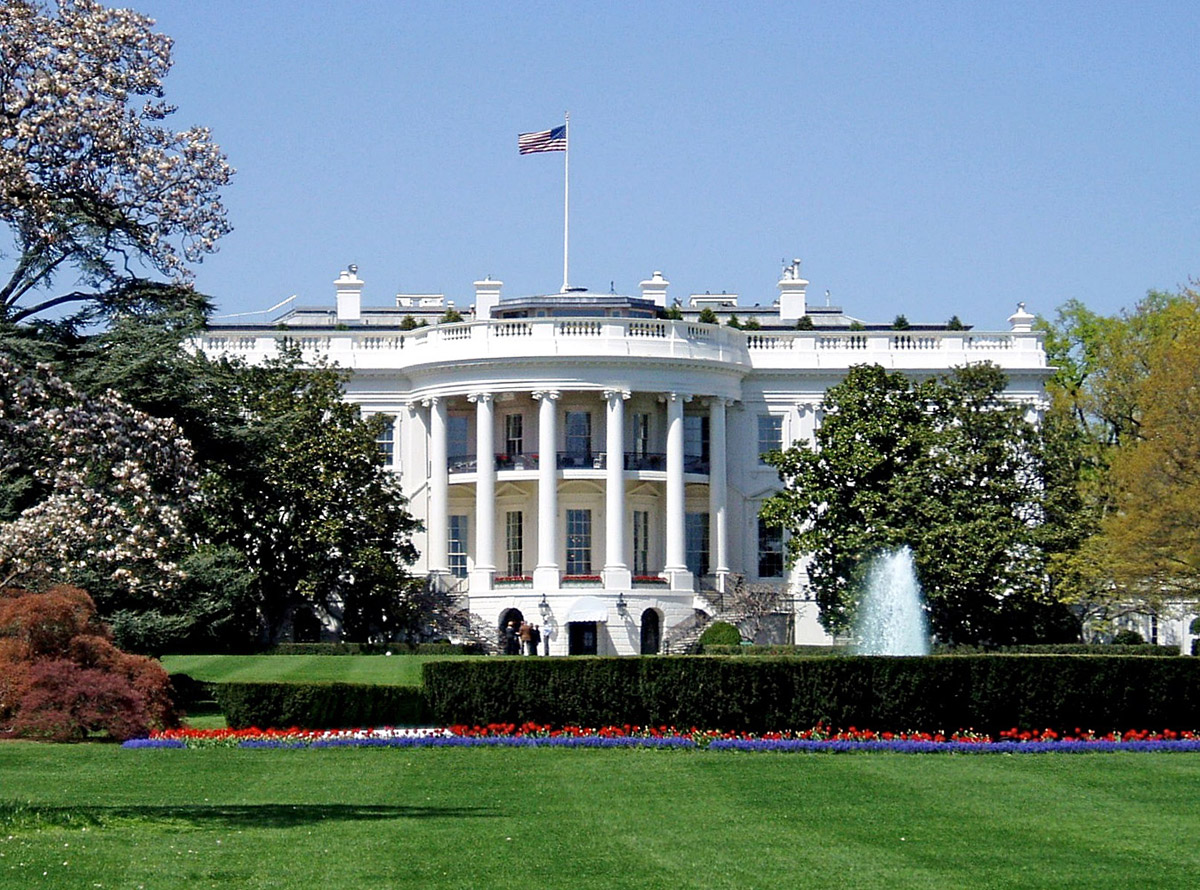 Potential GDP should also be boosted by two further packages that Biden plans to put to Congress.
Potential GDP should also be boosted by two further packages that Biden plans to put to Congress.
The first is a $2.2tr infrastructure investment plan, known as the American Jobs Plan. This is a 10-year plan to invest public money in transport infrastructure (such as rebuilding 20 000 miles of road and repairing bridges), public transport, electric vehicles, green housing, schools, water supply, green power generation, modernising the power grid, broadband, R&D in fields such as AI, social care, job training and manufacturing. This will be largely funded through tax increases, such as gradually raising corporation tax from 21% to 28% (it had been cut from 35% to 21% by President Trump) and taxing global profits of US multinationals. However, the spending will generally precede the increased revenues and thus will raise aggregate demand in the initial years. Only after 15 years are revenues expected to exceed costs.
The second is a yet-to-be announced plan to increase spending on childcare, healthcare and education. This should be worth at least $1tr. This will probably be funded by tax increases on income, capital gains and property, aimed largely at wealthy individuals. Again, it is hoped that this will boost potential GDP, in this case by increasing labour productivity.
With earlier packages, the total increase in public spending will be over $8tr. This is discretionary fiscal policy writ large.
Articles
- Biden’s $1.9 trillion COVID-19 bill wins final approval in House
Reuters, Susan Cornwell and Makini Brice (10/3/21)
- Biden’s Covid stimulus plan: It costs $1.9tn but what’s in it?
BBC News, Natalie Sherman (6/3/21)
- Biden’s $1.9 Trillion Challenge: End the Coronavirus Crisis Faster
New York Times, Jim Tankersley and Sheryl Gay Stolberg (22/3/21)
- Joe Biden writes a cheque for America – and the rest of the world
The Observer, Phillip Inman (13/3/21)
- Spend or save: Will Biden’s stimulus cheques boost the economy?
Aljazeera, Cinnamon Janzer (9/3/21)
- After Biden stimulus, US economic growth could rival China’s for the first time in decades
CNN, Matt Egan (12/3/21)
- Larry Summers, who called out inflation fears with Biden’s $1.9 trillion COVID-19 relief package, says the US is seeing ‘least responsible’ macroeconomic policy in 40 years
Business Insider, John L. Dorman (21/3/21)
- With $1.9 Trillion in New Spending, America Is Headed for Financial Fragility
Barron’s, Leslie Lipschitz and Josh Felman (30/3/21)
- Biden unveils ‘once-in-a generation’ $2tn infrastructure investment plan
The Guardian, Lauren Gambino (31/3/21)
- Biden unveils $2tn infrastructure plan and big corporate tax rise
Financial Times, James Politi (31/3/21)
- The Observer view on Joe Biden’s audacious spending plans
The Observer, editorial (11/4/21)
Videos
Questions
- Draw a Keynesian cross diagram to show the effect of an increase in benefits when the economy is operating below potential GDP.
- What determines the size of the benefits multiplier?
- Explain what is meant by the output gap. How might the pandemic and accompanying emergency health measures have affected the size of the output gap?
- How are expectations relevant to the effectiveness of the stimulus measures?
- What is likely to determine the proportion of the $1400 stimulus cheques that people spend?
- Distinguish between resource crowding out and financial crowding out. Is the fiscal stimulus package likely to result in either form of crowding out and, if so, what will determine by how much?
- What is the current monetary policy of the Fed? How is it likely to impact on the effectiveness of the fiscal stimulus?
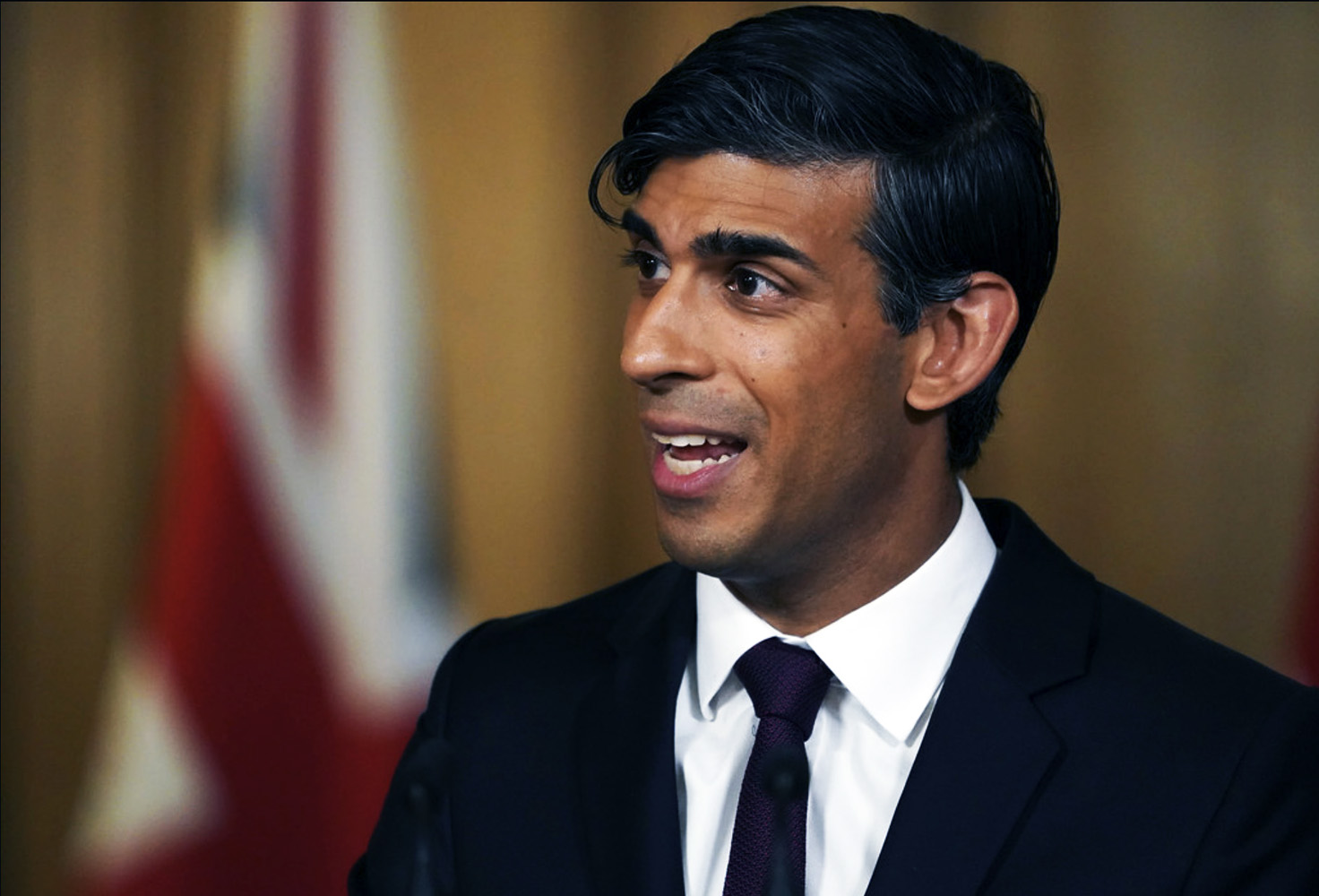 Rishi Sunak delivered his 2021 UK Budget on 3 March. It illustrates the delicate balancing act that governments in many countries face as the effects of the coronavirus pandemic persist and public-sector debt soars. He announced that he would continue supporting the economy through various forms of government expenditure and tax relief, but also announced tax rises over the medium term to begin addressing the massively increased public-sector debt.
Rishi Sunak delivered his 2021 UK Budget on 3 March. It illustrates the delicate balancing act that governments in many countries face as the effects of the coronavirus pandemic persist and public-sector debt soars. He announced that he would continue supporting the economy through various forms of government expenditure and tax relief, but also announced tax rises over the medium term to begin addressing the massively increased public-sector debt.
Key measures of support for people and businesses include:
- An extension of the furlough scheme until the end of September, with employees continuing to be paid 80% of their wages for hours they cannot work, but with employers having to contribute 10% in July and 20% in August and September.
- Support for the self-employed also extended until September, with the scheme being widened to make 600 000 more self-employed people eligible.
- The temporary £20 increase to Universal Credit, introduced in April last year and due to end on 31 March this year, to be extended to the end of September.
- Stamp duty holiday on house purchases in England and Northern Ireland, under which there is no tax liability on sales of less than £500 000, extended from the end of March to the end of June.
- An additional £1.65bn to support the UK’s vaccination rollout.
- VAT rate for hospitality firms to be maintained at the reduced 5% rate until the end of September and then raised to 12.5% (rather than 20%) for a further six months.
- A range of grants for the arts, sport, shops , other businesses and apprenticeships.
- Business rates holiday for hospitality firms in England extended from the end of March to the end of June and then with a discount of 66% until April 2022.
- 130% of investment costs can be offset against tax – a new tax ‘super-deduction’.
- No tax rises on alcohol, tobacco or fuel.
- New UK Infrastructure Bank to be set up in Leeds with £12bn in capital to support £40bn worth of public and private projects.
- Increased grants for devolved nations and grants for 45 English towns.
It has surprised many commentators that there was no announcement of greater investment in the NHS or more money for social care beyond the £3bn for the NHS and £1bn for social care announced in the November Spending Review. The NHS England budget will fall from £148bn in 2020/21 to £139bn in 2021/22.
Effects on borrowing and GDP
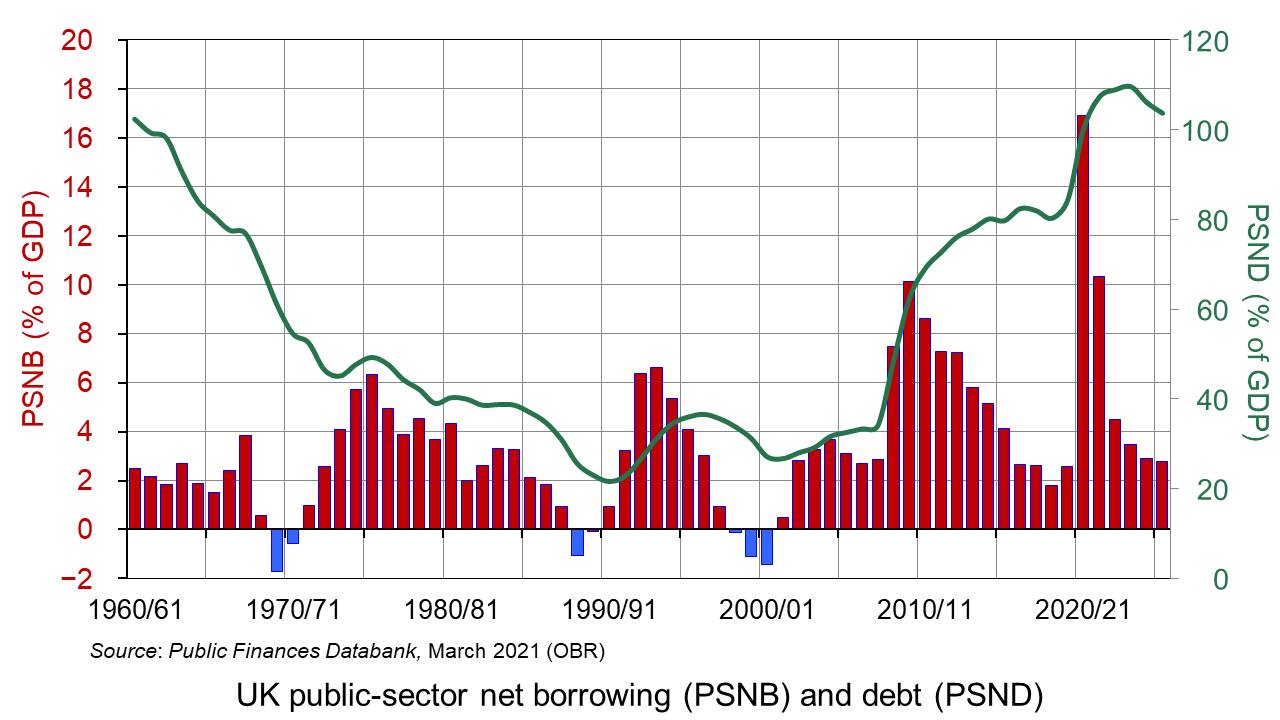
The net effect of these measures for the two financial years 2020 to 2022 is forecast by the Treasury to be an additional £37.5bn of government expenditure and a £27.3bn reduction in tax revenue (see Table 2.1 in Budget 2021). This takes the total support since the start of the pandemic to £352bn across the two years.
According to the OBR, this will result in public-sector borrowing being 16.9% of GDP in 2020/21 (the highest since the Second World War) and 10.3% of GDP in 2021/22. Public-sector debt will be 107.4% of GDP in 2021/22, rising to 109.7% in 2023/24 and then falling to 103.8% in 2025/26.
 Faced with this big increase in borrowing, the Chancellor also announced some measures to raise tax revenue beginning in two years’ time when, hopefully, the economy will have grown. Indeed, the OBR forecasts that GDP will grow by 4.0% in 2021 and 7.3% in 2022, with the growth rate then settling at around 1.7% from 2023 onwards. He announced that:
Faced with this big increase in borrowing, the Chancellor also announced some measures to raise tax revenue beginning in two years’ time when, hopefully, the economy will have grown. Indeed, the OBR forecasts that GDP will grow by 4.0% in 2021 and 7.3% in 2022, with the growth rate then settling at around 1.7% from 2023 onwards. He announced that:
- Corporation tax on company profits over £250 000 will rise from 19% to 25% in April 2023. Rates for profits under £50 000 will remain at the current rate of 19%, with the rate rising in stages as profits rise above £50 000.
- Personal income tax thresholds will be frozen from 2022/23 to 2025/26 at £12 570 for the basic 20% marginal rate and at £50 270 for the 40% marginal rate. This will increase the average tax rate as people’s nominal incomes rise.
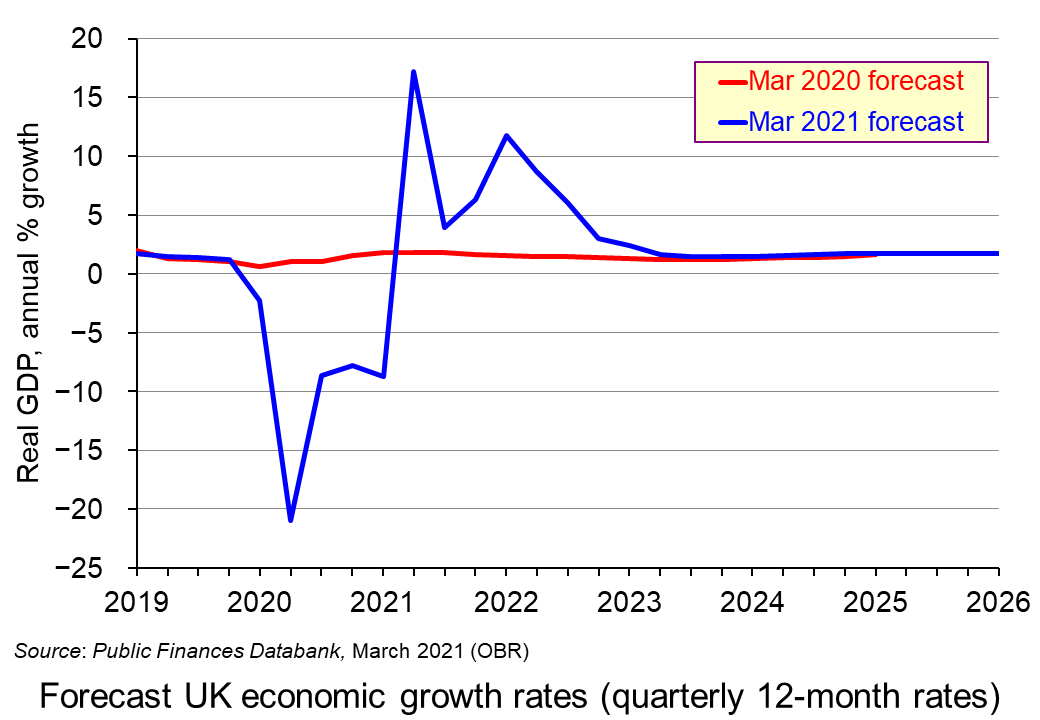 The policy of a fiscal boost now and a fiscal tightening later might pose political difficulties for the government as this does not fit with the electoral cycle. Normally, politicians like to pursue tighter policies in the early years of the government only to loosen policy with various giveaways as the next election approaches. With Rishi Sunak’s policies, the opposite is the case, with fiscal policy being tightened as the 2024 election approaches.
The policy of a fiscal boost now and a fiscal tightening later might pose political difficulties for the government as this does not fit with the electoral cycle. Normally, politicians like to pursue tighter policies in the early years of the government only to loosen policy with various giveaways as the next election approaches. With Rishi Sunak’s policies, the opposite is the case, with fiscal policy being tightened as the 2024 election approaches.
Another issue is the high degree of uncertainty in the forecasts on which he is basing his policies. If there is another wave of the coronavirus with a new strain resistant to the vaccines or if the scarring effects of the lockdowns are greater, then growth could stall. Or if inflation begins to rise and the Bank of England feels it must raise interest rates, then this would suppress growth. With lower growth, the public-sector deficit would be higher and the government would be faced with the dilemma of whether it should raise taxes, cut government expenditure or accept higher borrowing.
What is more, there are likely to be huge pressures on the government to increase public spending, not cut it by £4bn per year in the medium term as he plans. As Paul Johnson of the IFS states:
In reality, there will be pressures from all sorts of directions. The NHS is perhaps the most obvious. Further top-ups seem near-inevitable. Catching up on lost learning in schools, dealing with the backlog in our courts system, supporting public transport providers, and fixing our system for social care funding would all require additional spending. The Chancellor’s medium-term spending plans simply look implausibly low.
Articles and Briefings
- Budget 2021: Key points at-a-glance
BBC News (3/3/21)
- Budget 2021: Full round-up of what Chancellor Rishi Sunak has announced
MoneySavingExpert, Callum Mason (3/3/21)
- Budget 2021 at a glance: The key points from Chancellor Rishi Sunak’s speech
This is Money, Alex Sebastian (3/3/21)
 Budget 2021
Budget 2021IFS (3/3/21)
- Rishi Sunak delivers spend now, tax later Budget to kickstart UK economy
Financial Times, Jim Pickard, Chris Giles and George Parker (3/3/21)
- Swifter and more sustained? What did we learn about the UK’s economic outlook from Rishi Sunak’s Budget?
Independent. Ben Chu (3/3/21)
- Spending fast, taxing slow: Briefing Note
Resolution Foundation, Torsten Bell, Mike Brewer, Nye Cominetti, Karl Handscomb, Kathleen Henehan, Lindsay Judge, Jack Leslie, Charlie McCurdy, Cara Pacitti, Hannah Slaughter, James Smith, Gregory Thwaites & Daniel Tomlinson (4/3/21)
- JRF Spring Budget 2021 analysis and briefing
Joseph Rowntree Foundation, Dave Innes and Katie Schmuecker (4/3/21)
- NHS, social care and most vulnerable ‘betrayed’ by Sunak’s budget
The Guardian, Robert Booth ,Patrick Butler and Denis Campbell (3/3/21)
- Spend now, pay later: Sunak flags major tax rises as Covid bill tops £400bn
The Guardian, Heather Stewart and Larry Elliott (3/3/21)
- Rishi Sunak digs in for battle against financial cost of Covid
The Guardian, Larry Elliott (3/3/21)
- Tax and spending experts say Sunak’s budget doesn’t add up
The Guardian, Larry Elliott and Heather Stewart (4/3/21)
 Budget 2021: Prepare for a dramatic rollercoaster ride after chancellor’s give-then-take budget
Budget 2021: Prepare for a dramatic rollercoaster ride after chancellor’s give-then-take budgetSky News, Ed Conway (3/3/21)
Official documents and data
Questions
- Assess the wisdom of the timing of the changes in tax and government expenditure announced in the Budget.
- Universal credit was increased by £20 per week in April 2020 and is now due to fall back to its previous level in October 2021. Have the needs of people on Universal Credit increased during the pandemic and, if so, are they likely to return to their previous level in October?
- In the past, the government argued that reductions in the rate of corporation tax would increase tax revenue. The Chancellor now argues that increasing it from 19% to 25% will increase tax revenue. Examine the justification for this increase and the significance of relative profit tax rates between countries.
- Investigate the effects on the public finances of the pandemic and government fiscal policy in two other countries. How do the effects compare with those in the UK?
- The Joseph Rowntree Foundation looks at poverty in the UK and policies to tackle it. It set five tests for the Budget. Examine its Budget Analysis and consider whether these tests have been met.
 The BBC podcast linked below looks at the use of quantitative easing since 2009 and especially the most recent round since the onset of the pandemic.
The BBC podcast linked below looks at the use of quantitative easing since 2009 and especially the most recent round since the onset of the pandemic.
Although QE was a major contributor to reducing the depth of the recession in 2009–10, it was barely used from 2013 to 2020 (except for a short period in late 2016/early 2017). The Coalition and Conservative governments were keen to get the deficit down. In justifying pay restraint and curbing government expenditure, Prime Ministers David Cameron and Theresa May both argued that there ‘was no magic money tree’.
But with the severely dampening effect of the lockdown measures from March 2020, the government embarked on a large round of expenditure, including the furlough scheme and support for businesses.
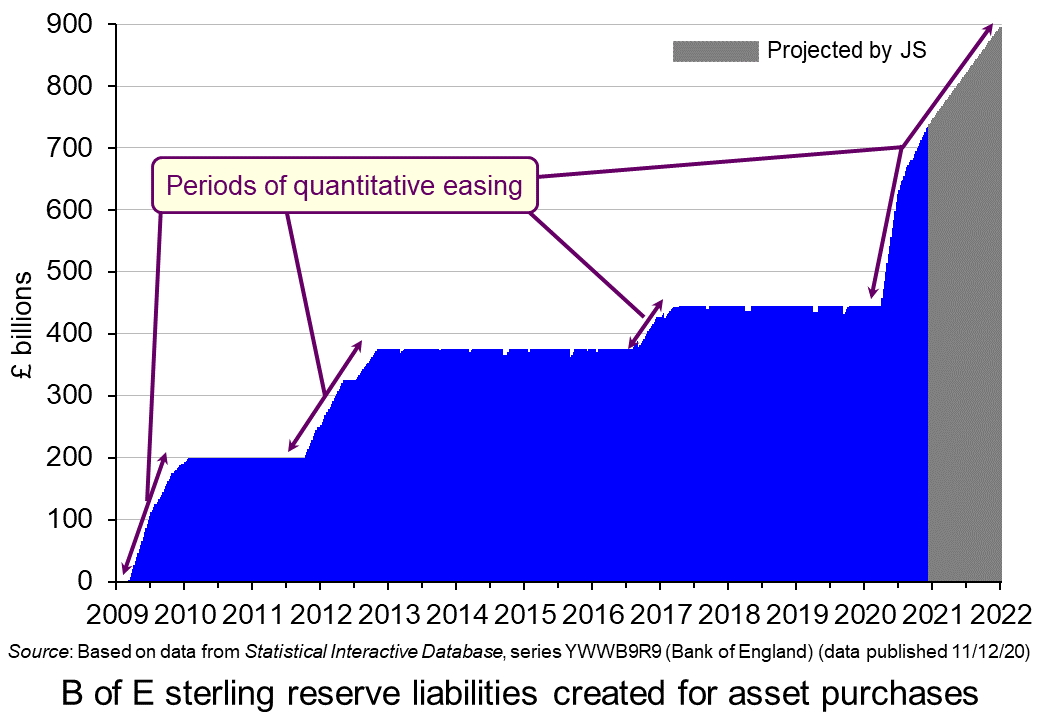 The resulting rise in the budget deficit was accompanied by a new round of QE from the beginning of April. The stock of assets purchased by the Bank of England rose from £445 billion (the approximate level it had been since March 2017) to £740 billion by December 2020 and is planned to reach £895 billion by the end of 2021.
The resulting rise in the budget deficit was accompanied by a new round of QE from the beginning of April. The stock of assets purchased by the Bank of England rose from £445 billion (the approximate level it had been since March 2017) to £740 billion by December 2020 and is planned to reach £895 billion by the end of 2021.
So with the effective funding of the government’s deficits by the creation of new money, does this mean that there is indeed a ‘magic money tree’ or, indeed, a ‘magic money forest’? And if so, is it desirable? Is it simply stoking up problems for the future? Or will, as modern monetary theorists maintain, the extra money, if carefully spent, lead to faster growth and a reducing deficit, with low interest rates making it easy to service the debt?
The podcast explores these issues. There is then a longer list of questions than normal relating to the topics raised in the podcast.
Podcast
Questions
- Which of the following are stocks and which are flows?
(a) Money
(b) Income
(c) The total amount people save each month
(d) The money held in savings accounts
(e) Public-sector net debt
(f) Public-sector net borrowing
(g) National income
(h) Injections into the circular flow of income
(i) Aggregate demand
(j) Wealth
- How do banks create money?
- What is the role of the Debt Management Office in the sale of gilts?
- Describe the birth of QE.
- Is raising asset prices the best means of stimulating the economy? What are the disadvantages of this form of monetary expansion?
- What are the possible exit routes from QE and what problems could occur from reducing the central bank’s stock of assets?
- Is the use of QE in the current Covid-19 crisis directly related to fiscal policy? Or is this use of monetary policy simply a means of hitting the inflation target?
- What are the disadvantages of having interest rates at ultra-low levels?
- Does it matter if the stock of government debt rises substantially if the gilts are at ultra-low fixed interest rates?
- What are the intergenerational effects of substantial QE? Does it depend on how debt is financed?
- How do the policy recommendations of modern monetary theorists differ from those of more conventional macroeconomists?
- In an era of ultra-low interest rates, does fiscal policy have a greater role to play than monetary policy?
 On 25 November, the UK government published its Spending Review 2020. This gives details of estimated government expenditure for the current financial year, 2020/21, and plans for government expenditure and the likely totals for 2021/22.
On 25 November, the UK government published its Spending Review 2020. This gives details of estimated government expenditure for the current financial year, 2020/21, and plans for government expenditure and the likely totals for 2021/22.
The focus of the Review is specifically on the effects of and responses to the coronavirus pandemic. It does not consider the effects of Brexit, with or without a trade deal, or plans for taxation. The Review is based on forecasts by the Office for Budget Responsibility (OBR). Because of the high degree of uncertainty over the spread of the disease and the timing and efficacy of vaccines, the OBR gives three forecast values for most variables – pessimistic, central and optimistic.
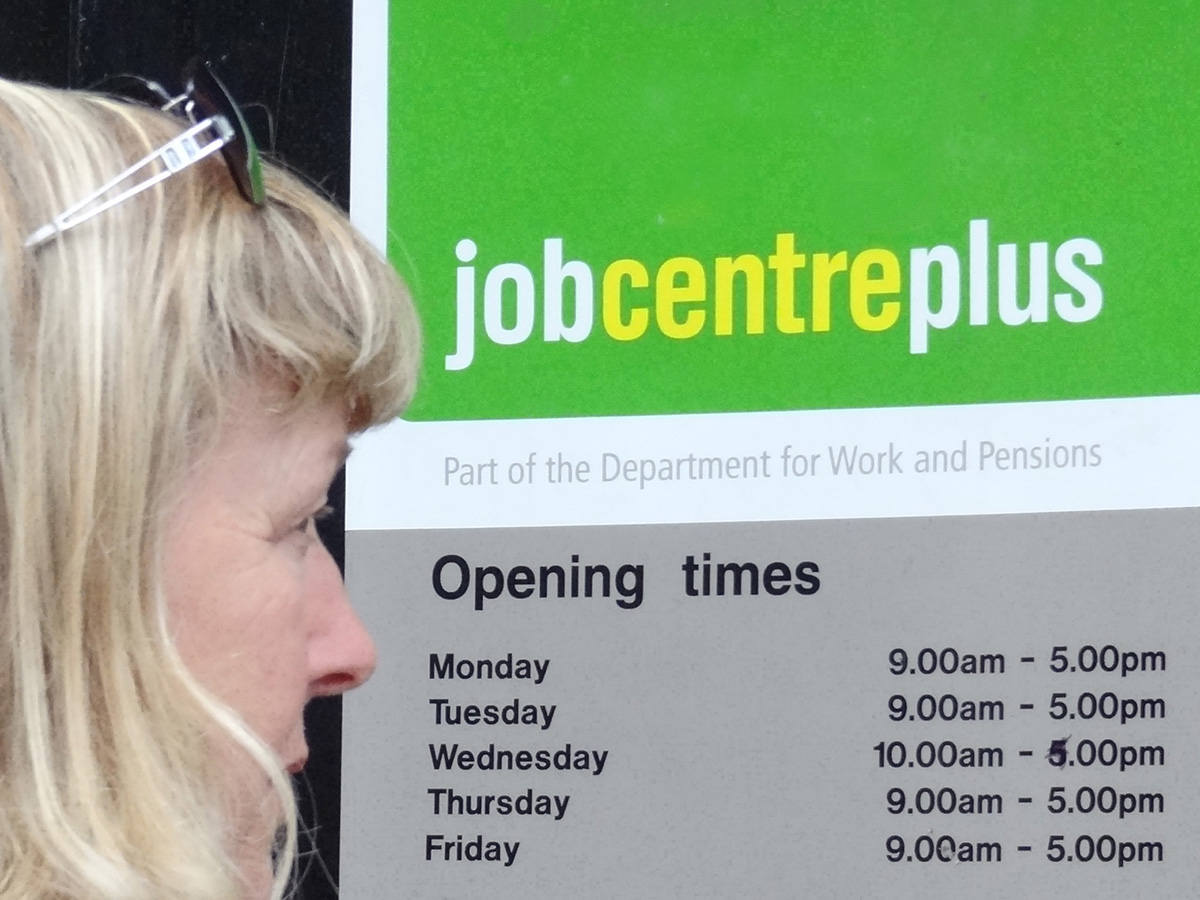 According to the central forecast, real GDP is set to decline by 11.3% in 2020, the largest one-year fall since the Great Frost of 1709. The economy is then set to ‘bounce back’ (somewhat), with GDP rising by 5.2% in 2021.
According to the central forecast, real GDP is set to decline by 11.3% in 2020, the largest one-year fall since the Great Frost of 1709. The economy is then set to ‘bounce back’ (somewhat), with GDP rising by 5.2% in 2021.
Unemployment will rise from 3.9% in 2019 to a peak of 7.5% in mid-2021, after the furlough scheme and other support for employers is withdrawn.
This blog focuses at the impact on government borrowing and debt and the implications for the future – both the funding of the debt and ways of reducing it.
Soaring government deficits and debt
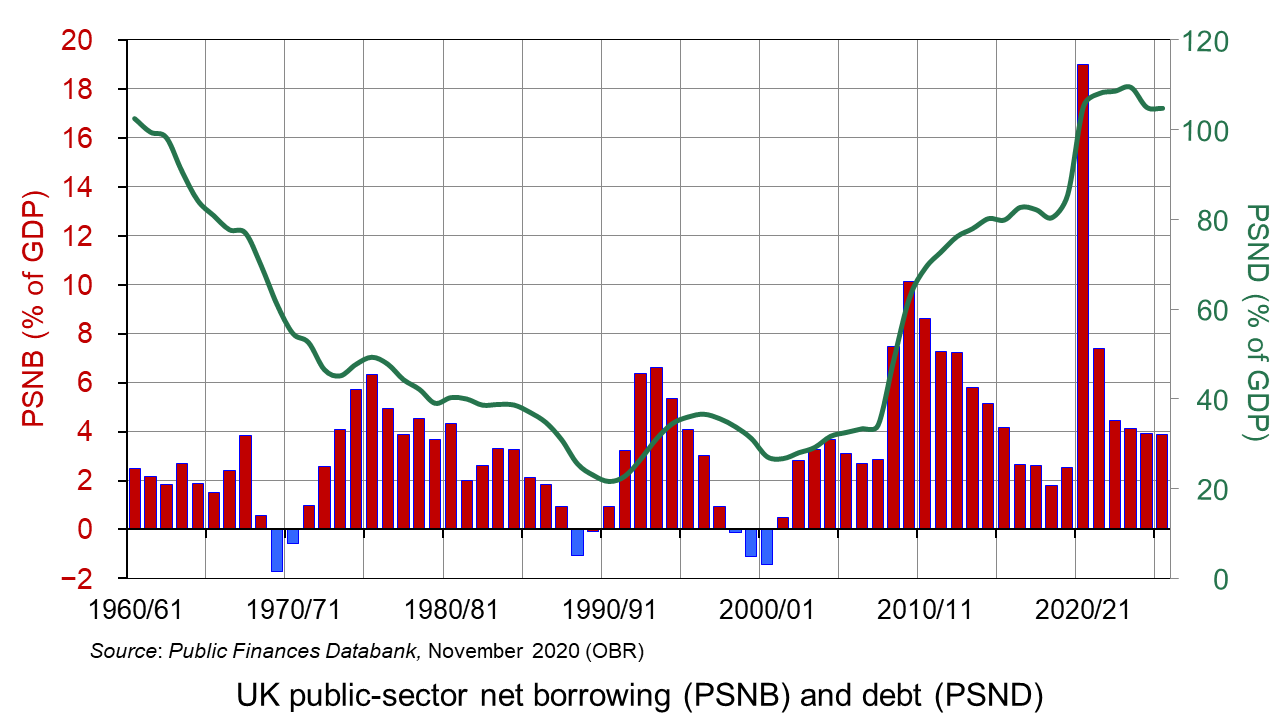
Government expenditure during the pandemic has risen sharply through measures such as the furlough scheme, the Self-Employment Income Support Scheme and various business loans. This, combined with falling tax revenue, as incomes and consumer expenditure have declined, has led to a rise in public-sector net borrowing (PSNB) from 2.5% of GDP in 2019/20 to a central forecast of 19% for 2020/21 – the largest since World War II. By 2025/26 it is still forecast to be 3.9% of GDP. The figure has also been pushed up by a fall in nominal GDP for 2020/21 (the denominator) by nearly 7%. (Click here for a PowerPoint of the above chart.)
The high levels of PSNB are pushing up public-sector net debt (PSNB). This is forecast to rise from 85.5% of GDP in 2019/20 to 105.2% in 2020/21, peaking at 109.4% in 2023/24.
The exceptionally high deficit and debt levels will mean that the government misses by a very large margin its three borrowing and debt targets set out in the latest (Autumn 2016) ‘Charter for Budget Responsibility‘. These are:
- to reduce cyclically-adjusted public-sector net borrowing to below 2% of GDP by 2020/21;
- for public-sector net debt as a percentage of GDP to be falling in 2020/21;
- for overall borrowing to be zero or in surplus by 2025/26.
But, as the Chancellor said in presenting the Review:
Our health emergency is not yet over. And our economic emergency has only just begun. So our immediate priority is to protect people’s lives and livelihoods.
Putting the public finances on a sustainable footing
Running a large budget deficit in an emergency is an essential policy for dealing with the massive decline in aggregate demand and for supporting those who have, or otherwise would have, lost their jobs. But what of the longer-term implications? What are the options for dealing with the high levels of debt?
1. Raising taxes. This tends to be the preferred approach of those on the left, who want to protect or improve public services. For them, the use of higher progressive taxes, such as income tax, or corporation tax or capital gains tax, are a means of funding such services and of providing support for those on lower incomes. There has been much discussion of the possibility of finding a way of taxing large tech companies, which are able to avoid taxes by declaring very low profits by diverting them to tax havens.
2. Cutting government expenditure. This is the traditional preference of those on the right, who prefer to cut the overall size of the state and thus allow for lower taxes. However, this is difficult to do without cutting vital services. 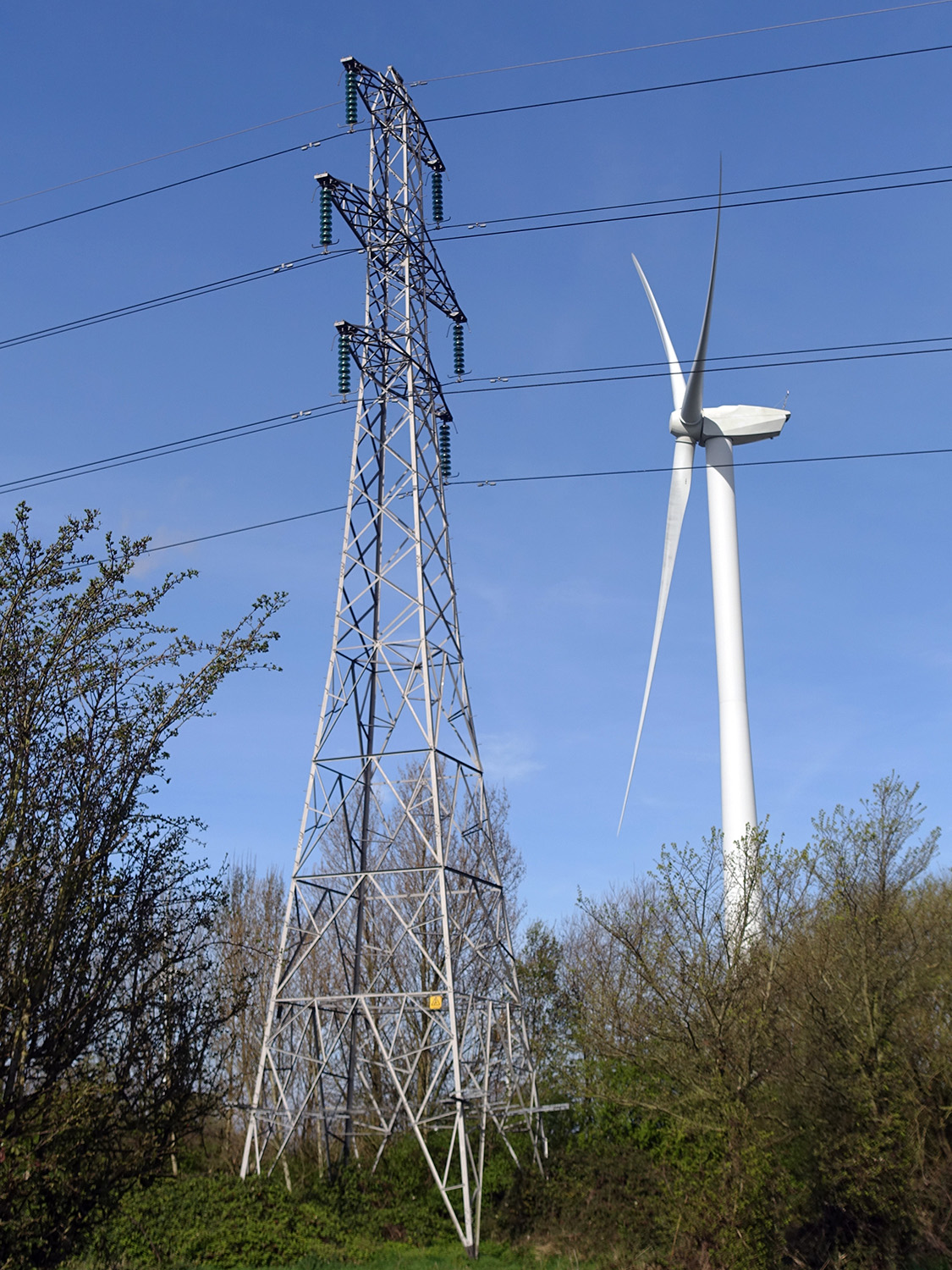 Indeed, there is pressure to have higher government expenditure over the longer term to finance infrastructure investment – something supported by the Conservative government.
Indeed, there is pressure to have higher government expenditure over the longer term to finance infrastructure investment – something supported by the Conservative government.
A downside of either of the above is that they squeeze aggregate demand and hence may slow the recovery. There was much discussion after the financial crisis over whether ‘austerity policies’ hindered the recovery and whether they created negative supply-side effects by dampening investment.
3. Accepting higher levels of debt into the longer term. This is a possible response as long as interest rates remain at record low levels. With depressed demand, loose monetary policy may be sustainable over a number of years. Quantitative easing depresses bond yields and makes it cheaper for governments to finance borrowing. Servicing high levels of debt may be quite affordable.
The problem is if inflation begins to rise. Even with lower aggregate demand, if aggregate supply has fallen faster because of bankruptcies and lack of investment, there may be upward pressure on prices. The Bank of England may have to raise interest rates, making it more expensive for the government to service its debts.
Another problem with not reducing the debt is that if another emergency occurs in the future, there will be less scope for further borrowing to support the economy.
 4. Higher growth ‘deals’ with the deficit and reduces debt. In this scenario, austerity would be unnecessary. This is the ‘golden’ scenario – for the country to grow its way out of the problem. Higher output and incomes leads to higher tax revenues, and lower unemployment leads to lower expenditure on unemployment benefits. The crucial question is the relationship between aggregate demand and supply. For growth to be sustainable and shrink the debt/GDP ratio, aggregate demand must expand steadily in line with the growth in aggregate supply. The faster aggregate supply can grow, the faster can aggregate demand. In other words, the faster the growth in potential GDP, the faster can be the sustainable rate of growth of actual GDP and the faster can the debt/GDP ratio shrink.
4. Higher growth ‘deals’ with the deficit and reduces debt. In this scenario, austerity would be unnecessary. This is the ‘golden’ scenario – for the country to grow its way out of the problem. Higher output and incomes leads to higher tax revenues, and lower unemployment leads to lower expenditure on unemployment benefits. The crucial question is the relationship between aggregate demand and supply. For growth to be sustainable and shrink the debt/GDP ratio, aggregate demand must expand steadily in line with the growth in aggregate supply. The faster aggregate supply can grow, the faster can aggregate demand. In other words, the faster the growth in potential GDP, the faster can be the sustainable rate of growth of actual GDP and the faster can the debt/GDP ratio shrink.
One of the key issues is the degree of economic ‘scarring’ from the pandemic and the associated restrictions on economic activity. The bigger the decline in potential output from the closure of firms and the greater the deskilling of workers who have been laid off, the harder it will be for the economy to recover and the longer high deficits are likely to persist.
Another issue is the lack of labour productivity growth in the UK in recent years. If labour productivity does not increase, this will severely restrict the growth in potential output. Focusing on training and examining incentives, work practices and pay structures are necessary if productivity is to rise significantly. So too is finding ways to encourage firms to increase investment in new technologies.
Podcast and videos
Articles
- Initial reaction from IFS researchers on Spending Review 2020 and OBR forecasts
IFS Press Release, Paul Johnson, Carl Emmerson, Ben Zaranko, Tom Waters and Isabel Stockton (25/11/200
- Rishi Sunak is likely to increase spending – which means tax rises will follow
IFS, Newspaper Article, Paul Johnson (23/11/20)
- Economic and Fiscal Outlook Executive Summary
OBR (25/11/20)
- UK’s Sunak says public finances are on ‘unsustainable’ path
Reuters, David Milliken (26/11/20)
- Rishi Sunak warns ‘economic emergency has only just begun’
BBC News, Szu Ping Chan (25/11/20)
- UK will need £27bn of spending cuts or tax rises, watchdog warns
The Guardian, Phillip Inman (25/11/20)
- What is tomorrow’s Spending Review all about?
The Institute of Chartered Accountants in England and Wales (24/11/20)
- Spending Review 2020: the experts react
The Conversation, Drew Woodhouse, Ernestine Gheyoh Ndzi, Jonquil Lowe, Anupam Nanda, Alex de Ruyter and Simon J. Smith (25/11/20)
OBR Data
Questions
- What is the significance of the relationship between the rate of economic growth and the rate of interest for financing public-sector debt over the longer term?
- What can the government do to encourage investment in the economy?
- Using OBR data, find out what has happened to the output gap over the past few years and what is forecast to happen to it over the next five years. Explain the significance of the figures.
- Distinguish between demand-side and supply-side policies. How would you characterise the policies to tackle public-sector net debt in terms of this distinction? Do the policies have a mixture of demand- and supply-side effects?
- Choose two other developed countries. Examine how their their public finances have been affected by the coronavirus pandemic and the policies they are adopting to tackle the economic effects of the pandemic.
 The coronavirus pandemic and the climate emergency have highlighted the weaknesses of free-market capitalism.
The coronavirus pandemic and the climate emergency have highlighted the weaknesses of free-market capitalism.  At the same time as the world has been grappling with the pandemic, global warming has contributed to extreme heat and wildfires in various parts of the world, such as western North America, the eastern Mediterranean and Siberia, and major flooding in areas such as western Europe and China. Governments again have intervened by providing support to people whose property and livelihoods have been affected. Also there is a growing urgency to tackle global warming, with some movement, albeit often limited, in implementing policies to achieve net zero carbon emissions by some specified point in the future. Expectations are rising for concerted action to be agreed at the international COP26 climate meeting in Glasgow in November this year.
At the same time as the world has been grappling with the pandemic, global warming has contributed to extreme heat and wildfires in various parts of the world, such as western North America, the eastern Mediterranean and Siberia, and major flooding in areas such as western Europe and China. Governments again have intervened by providing support to people whose property and livelihoods have been affected. Also there is a growing urgency to tackle global warming, with some movement, albeit often limited, in implementing policies to achieve net zero carbon emissions by some specified point in the future. Expectations are rising for concerted action to be agreed at the international COP26 climate meeting in Glasgow in November this year. Western governments seem more committed to spending on socially desirable projects, such as transport, communications and green energy infrastructure, education, science and health. They are beginning to pursue more active industrial and regional policies. They are also taking measures to tax multinationals (see the blog The G7 agrees on measures to stop corporate tax avoidance). Many governments are publicly recognising the need to tackle inequality and to ‘level up’ society. Active fiscal policy, a central plank of Keynesian economics, has now come back into fashion, with a greater willingness to fund expenditure by borrowing and, over the longer term, to use higher taxes to fund increased government expenditure.
Western governments seem more committed to spending on socially desirable projects, such as transport, communications and green energy infrastructure, education, science and health. They are beginning to pursue more active industrial and regional policies. They are also taking measures to tax multinationals (see the blog The G7 agrees on measures to stop corporate tax avoidance). Many governments are publicly recognising the need to tackle inequality and to ‘level up’ society. Active fiscal policy, a central plank of Keynesian economics, has now come back into fashion, with a greater willingness to fund expenditure by borrowing and, over the longer term, to use higher taxes to fund increased government expenditure. Introducing the Council for Inclusive Capitalism with the Vatican
Introducing the Council for Inclusive Capitalism with the Vatican On 10 March, the House of Representatives gave final approval to President Biden’s $1.9tr fiscal stimulus plan (the
On 10 March, the House of Representatives gave final approval to President Biden’s $1.9tr fiscal stimulus plan (the  Other measures include $350bn in grants for local governments depending on their levels of unemployment and other needs; $50bn to improve COVID testing centres and $20bn to develop a national vaccination campaign; $170bn to schools and universities to help them reopen after lockdown; and grants to small businesses and specific grants to hard-hit sectors, such as hospitality, airlines, airports and rail companies.
Other measures include $350bn in grants for local governments depending on their levels of unemployment and other needs; $50bn to improve COVID testing centres and $20bn to develop a national vaccination campaign; $170bn to schools and universities to help them reopen after lockdown; and grants to small businesses and specific grants to hard-hit sectors, such as hospitality, airlines, airports and rail companies. So the problem might be one of excessive stimulus, which in normal times could result in crowding out by driving up interest rates and dampening investment. However, the Fed is still engaged in a programme of quantitative easing. Between mid-March 2020 and the end of March 2021, the Fed’s
So the problem might be one of excessive stimulus, which in normal times could result in crowding out by driving up interest rates and dampening investment. However, the Fed is still engaged in a programme of quantitative easing. Between mid-March 2020 and the end of March 2021, the Fed’s  Potential GDP should also be boosted by two further packages that Biden plans to put to Congress.
Potential GDP should also be boosted by two further packages that Biden plans to put to Congress.  Rishi Sunak delivered his 2021 UK Budget on 3 March. It illustrates the delicate balancing act that governments in many countries face as the effects of the coronavirus pandemic persist and public-sector debt soars. He announced that he would continue supporting the economy through various forms of government expenditure and tax relief, but also announced tax rises over the medium term to begin addressing the massively increased public-sector debt.
Rishi Sunak delivered his 2021 UK Budget on 3 March. It illustrates the delicate balancing act that governments in many countries face as the effects of the coronavirus pandemic persist and public-sector debt soars. He announced that he would continue supporting the economy through various forms of government expenditure and tax relief, but also announced tax rises over the medium term to begin addressing the massively increased public-sector debt.
 Faced with this big increase in borrowing, the Chancellor also announced some measures to raise tax revenue beginning in two years’ time when, hopefully, the economy will have grown. Indeed, the OBR forecasts that GDP will grow by 4.0% in 2021 and 7.3% in 2022, with the growth rate then settling at around 1.7% from 2023 onwards. He announced that:
Faced with this big increase in borrowing, the Chancellor also announced some measures to raise tax revenue beginning in two years’ time when, hopefully, the economy will have grown. Indeed, the OBR forecasts that GDP will grow by 4.0% in 2021 and 7.3% in 2022, with the growth rate then settling at around 1.7% from 2023 onwards. He announced that: The policy of a fiscal boost now and a fiscal tightening later might pose political difficulties for the government as this does not fit with the electoral cycle. Normally, politicians like to pursue tighter policies in the early years of the government only to loosen policy with various giveaways as the next election approaches. With Rishi Sunak’s policies, the opposite is the case, with fiscal policy being tightened as the 2024 election approaches.
The policy of a fiscal boost now and a fiscal tightening later might pose political difficulties for the government as this does not fit with the electoral cycle. Normally, politicians like to pursue tighter policies in the early years of the government only to loosen policy with various giveaways as the next election approaches. With Rishi Sunak’s policies, the opposite is the case, with fiscal policy being tightened as the 2024 election approaches. The BBC podcast linked below looks at the use of quantitative easing since 2009 and especially the most recent round since the onset of the pandemic.
The BBC podcast linked below looks at the use of quantitative easing since 2009 and especially the most recent round since the onset of the pandemic.  The resulting
The resulting  According to the central forecast, real GDP is set to decline by 11.3% in 2020, the largest one-year fall since the Great Frost of 1709. The economy is then set to ‘bounce back’ (somewhat), with GDP rising by 5.2% in 2021.
According to the central forecast, real GDP is set to decline by 11.3% in 2020, the largest one-year fall since the Great Frost of 1709. The economy is then set to ‘bounce back’ (somewhat), with GDP rising by 5.2% in 2021. 
 Indeed, there is pressure to have higher government expenditure over the longer term to finance infrastructure investment – something supported by the Conservative government.
Indeed, there is pressure to have higher government expenditure over the longer term to finance infrastructure investment – something supported by the Conservative government. 4. Higher growth ‘deals’ with the deficit and reduces debt. In this scenario, austerity would be unnecessary. This is the ‘golden’ scenario – for the country to grow its way out of the problem. Higher output and incomes leads to higher tax revenues, and lower unemployment leads to lower expenditure on unemployment benefits. The crucial question is the relationship between aggregate demand and supply. For growth to be sustainable and shrink the debt/GDP ratio, aggregate demand must expand steadily in line with the growth in aggregate supply. The faster aggregate supply can grow, the faster can aggregate demand. In other words, the faster the growth in potential GDP, the faster can be the sustainable rate of growth of actual GDP and the faster can the debt/GDP ratio shrink.
4. Higher growth ‘deals’ with the deficit and reduces debt. In this scenario, austerity would be unnecessary. This is the ‘golden’ scenario – for the country to grow its way out of the problem. Higher output and incomes leads to higher tax revenues, and lower unemployment leads to lower expenditure on unemployment benefits. The crucial question is the relationship between aggregate demand and supply. For growth to be sustainable and shrink the debt/GDP ratio, aggregate demand must expand steadily in line with the growth in aggregate supply. The faster aggregate supply can grow, the faster can aggregate demand. In other words, the faster the growth in potential GDP, the faster can be the sustainable rate of growth of actual GDP and the faster can the debt/GDP ratio shrink.